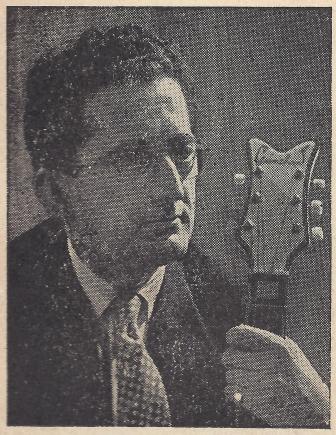Curly Clayton (Harvey Ormerod)
~ Jazz Guitarist 1919-2009
Curly Clayton with 1957 Grimshaw SS Guitar
The 1st year this Guitar was sold, the initialt batch were mainly White with Black trim
Curly Clayton, (real name Harvey Ormerod) was an ‘old School’ Session Guitarist who owned a small 3-track Studio in Highbury. He produced some early demo tracks by the Rolling Stones – Curly Clayton Sound Studios, Highbury, London, England
I have been trying to trace or track down Curly Clayton without any success except for a report of communication that Curly had had with someone re Eric Spencer (Piano & Arranger) joining the Edmundo Ros Orchestra. Eric Spencer used to be the Pianist in the BBC Scottish Variety Orchestra with Curly. Curly came South after a while and about the time Curly left Edmundo Ros he introduced Eric Spencer. Eric Spencer stayed long term with Edmundo Ros and did much arranging for the Band. I think Eric stayed until Ros retired the Band. I thus knew that Curly was still alive up until about 3-4 years ago. Reading about Curly on this Website takes me well back to my youth. I 1st met Curly when I was about 12 to 13 and I wanted to learn to play Guitar. Lessons were arranged at Pleyton’s School of Music, which was also a Music Shop in Camden Passage, The Angel, Islington. Curly taught Guitar there part-time. Incidentally, Pleyton was the publisher of his book. I went there every Saturday for about two years until Curly decided to stop teaching at Pleyton’s because he had set up his recording studio. However, there were a couple of us Students who he said he would continue to Teach or Coach providing were prepared to go to his Studio and if necessary wait until a break occurred in his Work schedule. It was by no means a hardship to be in that environment for a few hours on a Saturday with some really top Musicians calling in and usually playing. I stopped going to Curly’s Studio when I had to concentrate on ‘A’ Levels. Then, of course, higher education, work, marriage etc. took over. I met Curly’s wife on several occasions and his daughter also helped in the Studio, both were two very charming ladies. I can concur that Curly was indeed a very intelligent individual and also very generous with his time. David White.
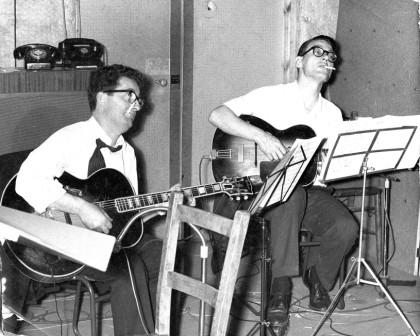
Curly Clayton – with Roy Plummer
Biography
Curly was an exceptional guitarist, by all accounts, but was much more than this – he was an extremely intelligent man who had a variety of interests – musician, producer, record company owner, author, motorcyclist & photographer. Curly was born in 1919 and grew up in the Highbury area of London. He started playing the Guitar when he was 16 and practised day & night. His musical influences were Eddie Lang, Charlie Christian & Django Reinhardt, from which he said “all others sprang”. One night, his friends egged him on to get on Stage when a local Big Band was playing and that was his 1st break into Music. An early news clipping from the Melody Maker, with Curly appearing under his real surname (Ormerod) – he told me that he started using Clayton (another family name) because he got fed up of having to spell out his real name to everyone. He worked in Glasgow for 2 years WW2 for the BBC Scottish Variety Orchestra as the featured Soloist. Curly also worked for a variety of Big Bands, including Sid Millward, Edmundo Ros, Eddie Calvert, Frank Weir, Stanley Black & Felix Mendelssohn’s Hawaiians. Whilst working for Eddie Calvert, he appeared in a small Musical Film in 1939, listed as Curly Ormerod called Eddie Carroll and his Boys (the others being Gavin Owen & Billy Day)
Directed by Horace Shepherd Synopsis: Two young jazz guitarists cannot believe their luck when they are stumbled upon by their idol while playing in the park.
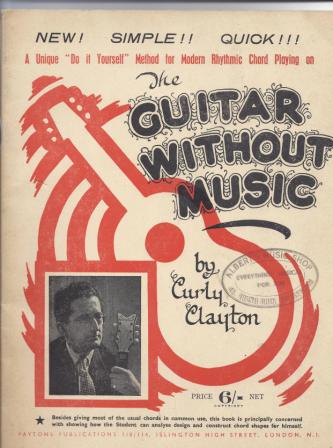
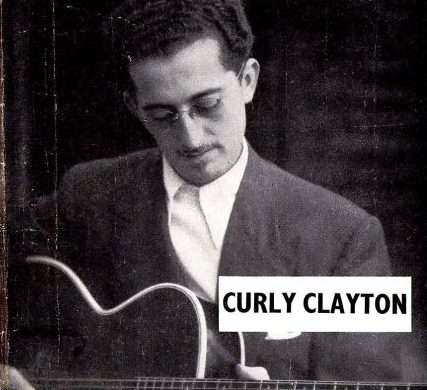 Curly was not only a noted Jazz Guitarist, he played Latin American style for several of these Bands and in Session, being the House Guitarist for Melodisc Records who made Calypso Recordings for sale back in the West Indies. He frequently played at 2 Carribbean Clubs in London at the time – one in Denman Street and the Sugar Hill Club, Mason’s Yard off St James. Curly also published a number of articles in the music press of the day – making the front cover of BMG in September 1949, as well as 2 books – The Guitar Without Music in 1957 & 1001 Chords for Jazz Guitarists. Curly also worked in the new arena of TV Ad Music, as shown by a story posted by a user of Spectorpop website “Back in the summer of 1955“, British advertising agencies were just coming to terms with the concept. The 1st Agency to specially record a piece of Music for an Ad was J Walter Thompson on Monday 1st August 1955 when George Browne & his Calypso-Mambo Band recorded a one-minute song for use on a Pilot Commercial. Besides George, who played the Guitar and sang, there was Curly Clayton who also played Guitar & Pat Ryan on Bongos.”
Curly was not only a noted Jazz Guitarist, he played Latin American style for several of these Bands and in Session, being the House Guitarist for Melodisc Records who made Calypso Recordings for sale back in the West Indies. He frequently played at 2 Carribbean Clubs in London at the time – one in Denman Street and the Sugar Hill Club, Mason’s Yard off St James. Curly also published a number of articles in the music press of the day – making the front cover of BMG in September 1949, as well as 2 books – The Guitar Without Music in 1957 & 1001 Chords for Jazz Guitarists. Curly also worked in the new arena of TV Ad Music, as shown by a story posted by a user of Spectorpop website “Back in the summer of 1955“, British advertising agencies were just coming to terms with the concept. The 1st Agency to specially record a piece of Music for an Ad was J Walter Thompson on Monday 1st August 1955 when George Browne & his Calypso-Mambo Band recorded a one-minute song for use on a Pilot Commercial. Besides George, who played the Guitar and sang, there was Curly Clayton who also played Guitar & Pat Ryan on Bongos.”
Throughout the 1940s through to the 1970s, Curly worked as a Session Musician and Sound Engineer, in Clubs around London and also worked as a private Guitar Tutor. Around this time, he also started opened a small recording Studio in Highbury Place, which I believe was called Curly Clayton’s Sound Studio. This was where he recorded the famous 1st Session with the Rolling Stones in 1962 (for which Curly says he was paid the grand sum of £3! or £1 oper track). Although this is what Curly seems to be remembered for above all else, he did not regard this as anything more than a simple recording job. The 3 tracks, produced as a Demo for EMI.
The Recording Studio was located in a large house that recently was featured in the Sunday Telegraph, where it was intact as one house. Curly described it to me “When we were there, we took over the 1st Floor Flat as well eventually because the Studio Sounds came up there and the owner couldn’t stand it. He sportingly decided to move into the Coach House he had designed alongside, and let us have the extra. We had the main Drawing Room & Veranda of the original house and the Basement Studio beneath all for £7 a week. We had to leave in 1963 because the Owner wanted to sell the lot with the Garages etc for £19,000”. Curly then moved his Studio to Swan Yard, just around the corner. During this time Curly recorded 100s of young bands – The Caravelles – “You Don’t Have To Be A Baby To Cry”, The Pathfinders (1964) “I’m Ashamed”, tracks with The Monotones, Dave Cooke, Dave Stopp, The Dave Clark Five & Rod Stewart, to name a few. He also recorded a song called “Space Walk” by the Vikings, but this was eventually released under the name of Gemini, with a different Producer listed but it was the same recording. Bob Jackson recorded several times at Curly’s Studio and remembers Curly well – “I recorded many song demos & theme music in his Studio. Curly had a great understanding of Musicians and how they reacted under recording-conditions. This coupled with his fantastic sense of humour meant that he was simply a pleasure to work with. Curly was very kind to me giving me many hours of free recording time and lots of encouragement.”
I came across your very interesting site when I was trawling the web about Curly Clayton and noticed that you mentioned ‘The Pathfinders’ from Birkenhead. I was the drummer with the band when we recorded “I’m Ashamed” in March 1964. I still have some memories of the session in Highbury. Various rooms downstairs, including one with egg-boxes stuck on the wall. He recorded my snare drum with a tea-towel draped over it- horrible to play but I guess it gave him the required sound. About that time Los Indios Tabajaras had a hit with “Maria Elena” and Curly played us a recording he had made of a song in the same style (can’t remember the title) that he had submitted to a recording company (?), I guess without success. I also seem to remember we went round the corner somewhere to a cafe for refreshments. I’d be interested to know how you came by the info about The Pathfinders, maybe you just found the website this gives a history of the band including our brief encounter with Curly. If you or anyone else out there has any more info, photos etc. about Curly and in particular about the Highbury studio I’d be glad to hear from you. Tony A
As well as standard Rock & Pop music, in the late 1960s / early 1970s, Curly moved in a different direction when he started up Coimbra Recordings which specialised in Catholic Music. It was in 1975 that Curly recorded The Mass at Downham Market, which was surprisingly topical. At the time, there was controversy in the Catholic Church regarding the abandonment of the Latin Mass as a result of the Vatican II reforms by Pope Paul. One traditionalist in Downham Market, Fr Oswald Baker, continued with the Latin Mass and drew Catholics from around the country. Many other recordings were completed such as the Faith of Our Fathers and The Mass at Lille.
Br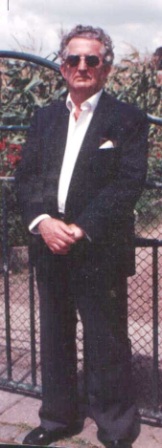 itish traditionalists (and some in other countries) are familiar with the recordings of the traditional Catholic liturgy made by the Coimbra Recording Company to the very highest professional standards – recordings which have been acclaimed for their excellence even by secular critics. The man behind Coimbra recordings is my very good friend Harvey Ormerod and Harvey is a man who simply could not stand back and allow an event like the Mass at Lille to remain nothing more than a memory in the minds of those who had the privilege to be present. He phoned me the day before the Mass and said that he hoped to get over to France to Record it. He later phoned me back to say that it couldn’t be done. He had contacted every major Record Company in France but not one would cooperate. They all said that at such short notice it was a complete impossibility and, in any case, 29th August 1976 came during a period of public holiday and if it hadn’t been impossible already it would have been impossible in any case (this is known as Gallic logic). But Harvey did not give up. He had made an arrangement by phone to meet an independent Recording Engineer at Lille. He didn’t know the engineer, the engineer didn’t know him; neither one knew if the other was in good faith, and they were to meet in the parking lot at Lille where Harvey would lookout for a grey Citröen Car. Harvey Ormerod duly arrived in Lille on the morning of 29th August, went to the parking lot of the International Fair, and found several 1,000 cars there already including 100s of grey Citroens. He virtually abandoned hope. Seconds later there was a tap on his shoulder and a smiling Frenchman greeted him. He took Harvey to a Recording Van from which cables let into the Auditorium through a freshly made hole in the brick wall. Only a French Engineer would have overcome the problem of gaining entrance to the Auditorium in such a direct manner. – Michael D
itish traditionalists (and some in other countries) are familiar with the recordings of the traditional Catholic liturgy made by the Coimbra Recording Company to the very highest professional standards – recordings which have been acclaimed for their excellence even by secular critics. The man behind Coimbra recordings is my very good friend Harvey Ormerod and Harvey is a man who simply could not stand back and allow an event like the Mass at Lille to remain nothing more than a memory in the minds of those who had the privilege to be present. He phoned me the day before the Mass and said that he hoped to get over to France to Record it. He later phoned me back to say that it couldn’t be done. He had contacted every major Record Company in France but not one would cooperate. They all said that at such short notice it was a complete impossibility and, in any case, 29th August 1976 came during a period of public holiday and if it hadn’t been impossible already it would have been impossible in any case (this is known as Gallic logic). But Harvey did not give up. He had made an arrangement by phone to meet an independent Recording Engineer at Lille. He didn’t know the engineer, the engineer didn’t know him; neither one knew if the other was in good faith, and they were to meet in the parking lot at Lille where Harvey would lookout for a grey Citröen Car. Harvey Ormerod duly arrived in Lille on the morning of 29th August, went to the parking lot of the International Fair, and found several 1,000 cars there already including 100s of grey Citroens. He virtually abandoned hope. Seconds later there was a tap on his shoulder and a smiling Frenchman greeted him. He took Harvey to a Recording Van from which cables let into the Auditorium through a freshly made hole in the brick wall. Only a French Engineer would have overcome the problem of gaining entrance to the Auditorium in such a direct manner. – Michael D
Curly and moved with his wife to Ponte Delgado in the Azores Islands in the 1980s. Curly taught some Guitar lessons there but was largely retired and lived there until his death in 2009, at the age of 90. –Acknowledgements to Cathy D for Curly’s Biography.
Curly’s Encounter with Django
I used to know the Jazz Guitarist Curly Clayton very well as he had a Studio near me in London and I’d often do Sessions for him with other guys locally like Clem Catini (The Drummer on the original Telstar). Curly used to play Guitar for the Edmundo Ros Orchestra and one day while he was playing a guy said to him. “Hey guess who’s sitting over there in the corner Curly, it’s Django Reinhardt!” Curly reckoned he nearly crapped himself, but during the break went over to where Reinhardt was sitting. He reckons he had a woman in each arm and a pint tumbler of Gin. Curly asks him if he wants to play and Reinhardt sort of grunted a – Non!.
Back on stage sometime later Reinhardt suddenly strolls up and points to Curly’s Guitar (A Gibson L5). Curly hands it to him and the Bandleader (Edmundo Ros – Coconut Grove in Regents Street) asks him what he wants to play. Reinhardt shrugs his shoulders, so eager to get things going the Bandleader suggests ‘Sweet Georgia Brown’. Reinhardt nods approval and they ask him what key he wants to do it in.. Again Reinhardt just shrugs. Anyway, they kick off in the written key and Reinhardt just comes in. Curly said he just sat there watching as Reinhardt played 24 choruses of ‘Sweet Georgia Brown’ and not one the same as the last. Then suddenly halfway through a Chorus he just gets up smiles and hands Curly back his Guitar and walks off back to his table, his women and the Gin. He didn’t even wait for the Band to finish or for anyone to applaud. Curly observed him all evening and said that he was an amazing person. In fact extremely childish in his behaviour and he sat there with these women and his drink, giggling & laughing like a little kid in a sweet shop. – PhilX
Reinhardt…knew what worked and what did not…he just did not have the words of theory to say it…he probably thought instinctively what was precisely correct.
The Rollin’ Stones then made a record, albeit only an acetate (demo disc). On Saturday 26th October ’63 the Marquee line up entered Jazz Guitarist Curly Clayton’s Studio near the old Arsenal Football Ground in Highbury, North London. According to Bill Wyman there was a single Microphone in the middle of the room and Sound balance was achieved by moving Instruments around the room. The tracks recorded were Bo Diddley’s You Can’t Judge A Book By The Cover, Muddy Waters Soon Forgotten and Jimmy Reed’s Close Together. The Curly sent a copy of the acetate to Neville Skrimshire at EMI Records and he told Drummer Tony Chapman “You’ll never get anywhere with that singer.”
October 1965: London,
Curly Clayton Sound Studio. Producer/Sound engineer: Curly Clayton.
– Soon Forgotten (James Oden) -unverified
– Close Together (Jimmy Reed) -unverified
– You Can’t Judge A Book By The Cover (Willie Dixon)
Line-up: Mick Jagger (voc) /Keith Richards (gtr) / Brian Jones (gtr) / Ian Stewart (p)/Dick Taylor (bass)/Tony Chapman (dr)
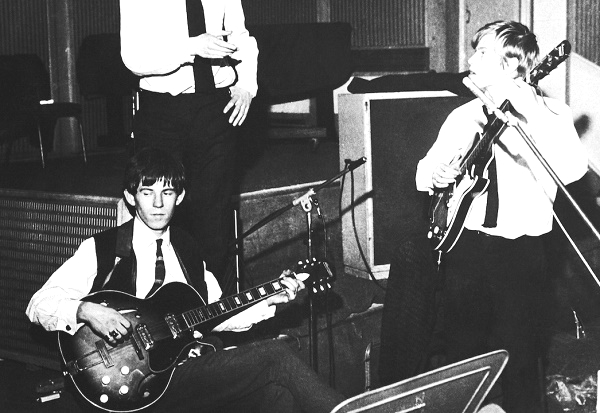
We went to see a Record Producer called Curly Clayton. he had a Studio in Highbury London, and was a great rival of Joe Meek – who had a Studio just up the road.
We met a musician called Curly Clayton, an old school session guitarist who owned a small 3-track studio in Highbury. He listened to our material and promised that he would secure a record contract for us within six months. This he did, and we signed to EMI.
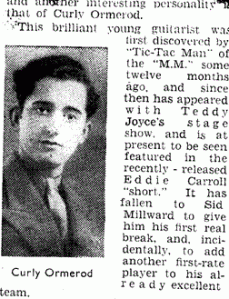
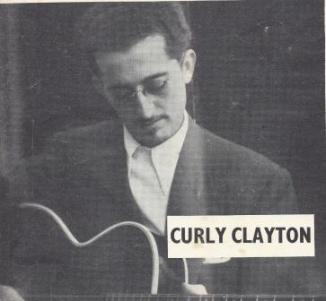
The article here mentions Curly’s appearance in a short Film when he was with Eddie Carroll but it was Sid Millward who gave him his 1st real break by adding him his Band which also featured Kenny Baker on 2nd Trumpet. Sid Millward’s Orchestra was the Resident Band for the 1940 9th April Imperial Theatre, Brighton which was owned by Jack Buchanan, Star of the opening show, Top Hat & Tails, whose Company built the Theatre as a Drama & Variety Theatre Curly has listed the document as 1940 – he would have been about 20 when this appeared.

A pensive Curly Clayton (Right) with Roger Mealy & Patrick Costello – The Producers
